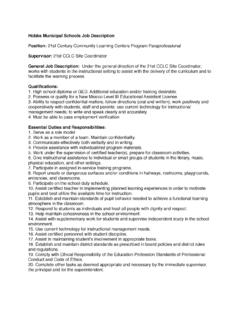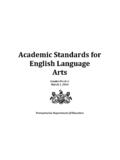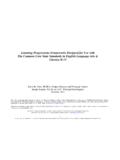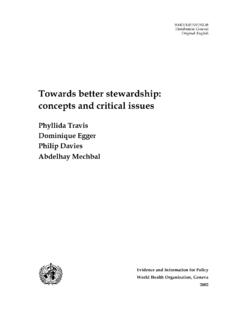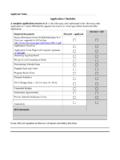Transcription of Grade 12 English Language Arts, Quarter 1, Unit 1.1 ...
1 Grade 12 english language arts , Quarter 1, Unit Etymology/Word Patterns Overview Number of instructional days: 10 (1 day = 46 minutes). Students read closely and analyze epic poems from the Anglo-Saxon period of British history with accompanying informational text concerning daily life in the Anglo-Saxon period, specifically focusing on the meaning of the words as they relate to and evolve from Anglo-Saxon roots and literary context as well as how the meaning of each term evolves throughout the course of the text. Students utilize multiple research sources such as a thesaurus, dictionary, and the historical information in the text to create original sentences and paragraphs that describe the literary and cultural elements of the period using Anglo-Saxon vocabulary words.
2 Students analyze the history of words and their evolution from the original meanings to their present-day uses and are able to use the words in both contexts. Students work with a predetermined list of words that originated in the Anglo-Saxon Language . A. thesaurus, dictionary, and historical information provide the meanings of the words as encountered in the original context, a definition in modern American English , synonyms, antonyms, and other information to establish a thorough definition and proper usage. Study of synonyms and antonyms leads students to recognize the nuances and the evolution of the meaning of words applied to the currently assigned text.
3 Discussion clarifies the pronunciations and associations of the words, and students subsequently feel ownership of the words and gain an ability to use them in original writing. This unit is at the beginning of the year because it establishes new ways for students to derive meanings of unfamiliar vocabulary, which enhances their ability to read increasingly complex texts independently. It also reinforces the use of a variety of research sources as learned in prior years, which will improve the students' effectiveness in their research projects later in the year.
4 As with all units aligned to the Common Core State Standards, students should read texts within the appropriate range of complexity. Students should have the opportunity to read texts that are challenging for them, with support from the instructor as necessary, and texts that they can read fluently. Additionally, students should focus on doing close readings and supporting their ideas in reading and writing with evidence from the texts they read. Concepts to Be Learned and Skills to Be Used DETERMINE the meaning of words and phrases in text.
5 O Figurative meanings. o Connotative meanings. o Technical meanings. Hobbs Municipal Schools with process support from the Charles A. Dana Center at the University of Texas at Austin 1 Grade 12 english language arts , Quarter 1, Unit Etymology/Word Patterns (10 days) ANALYZE the impact of word choice on meaning and tone. o Multiple meanings. o Language that is particularly fresh, engaging, or beautiful. ANALYZE the use and refinement of key terms over the course of the text. CONDUCT research projects. o ANSWER a question.
6 O SOLVE a problem. o NARROW/BROADEN the inquiry when appropriate. o SYNTHESIZE multiple sources. o DEMONSTRATE understanding of the subject. GATHER relevant information from multiple authoritative sources. o Print sources. o Digital sources. USE advanced searches effectively. ASSESS strengths and limitations of each source. o Task. o Purpose. o Audience. INTEGRATE information into the text. o MAINTAIN flow of ideas. o AVOID plagiarism and overreliance on any one source. o FOLLOW standard format for citation. FOLLOW standard format for citation.
7 INITIATE effective collaborative discussions. PARTICIPATE effectively in collaborative discussions. o One-on-one. o Groups. o Teacher-led. o Diverse partners. BUILD on others' ideas. Hobbs Municipal Schools with process support from the Charles A. Dana Center at the University of Texas at Austin 2 Grade 12 english language arts , Quarter 1, Unit Etymology/Word Patterns (10 days) EXPRESS their own ideas clearly and persuasively. PREPARE for discussions. o READ text. o RESEARCH material under study. o REFER to evidence from text.
8 STIMULATE thoughtful, well-reasoned exchange of ideas. DEMONSTRATE command of conventions when writing or speaking. o Grammar. o Usage. RESOLVE issues of usage. o CONSULT references (dictionary, grammar handbook). DETERMINE the meaning of words and phrases. o Unknown. o Multiple meanings. CHOOSE from a range of strategies to determine meaning. IDENTIFY patterns of word changes. USE appropriate word forms to indicate word forms to indicate various parts of speech. VERIFY preliminary determination of word meaning. DEMONSTRATE understanding of word meanings.
9 O Figurative Language . o Word relationships. o Nuances of words with similar denotations. Essential Questions What influence do Anglo-Saxon root words have on modern American English ? How does the knowledge of a word's etymology and cultural origin assist in the determination of current usage? How does researching root words enhance a student's working vocabulary? How does knowing the background of vocabulary improve students' writing? Hobbs Municipal Schools with process support from the Charles A. Dana Center at the University of Texas at Austin 3 Grade 12 english language arts , Quarter 1, Unit Etymology/Word Patterns (10 days) Written Curriculum The Common Core standards for this unit are listed in their complete form, including all numbering and strand information and exactly as they appear in the CCSS.
10 Any portions of the standard(s) not addressed in this unit will be marked with a strikethrough to clarify the focus of this unit's activities. There will most likely be standards from more than one strand in this section. The following standards are the focus of this unit of study: Reading Standards for Literature Craft and Structure Determine the meaning of words and phrases as they are used in the text, including figurative and connotative meanings; analyze the impact of specific word choices on meaning and tone, including words with multiple meanings or Language that is particularly fresh, engaging, or beautiful.
